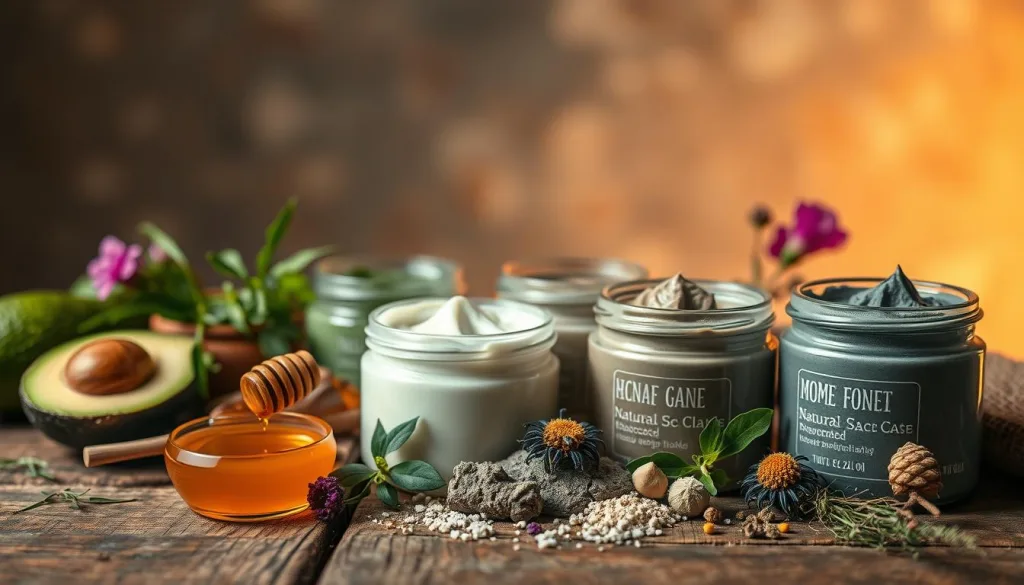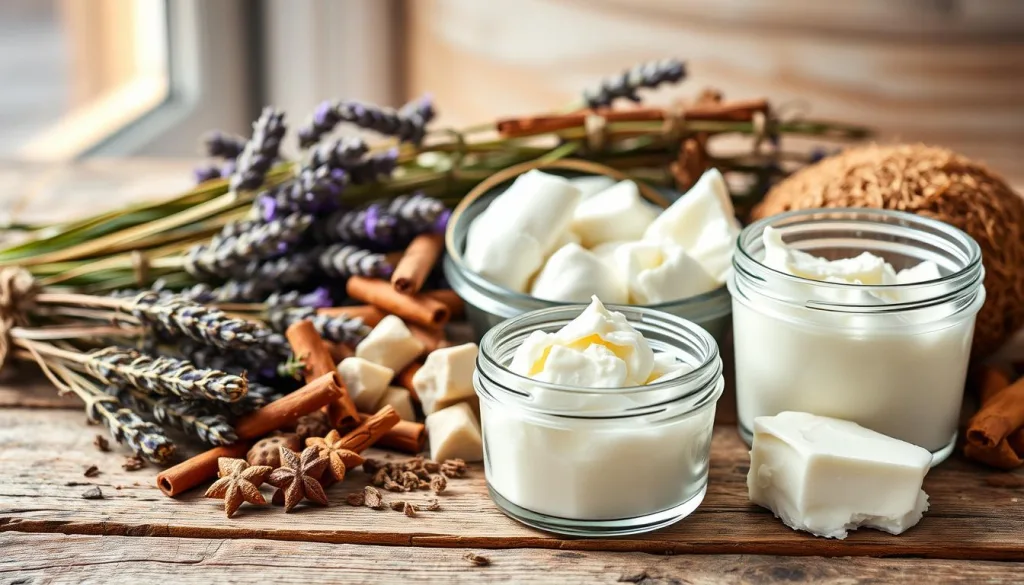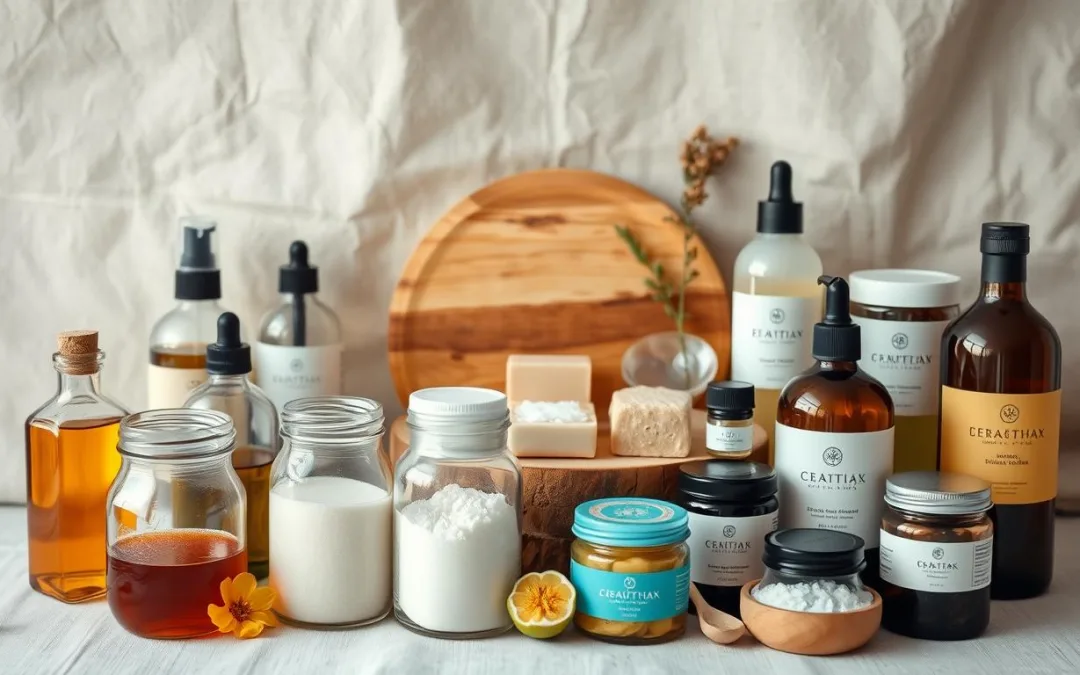Welcome to the world of DIY natural skincare products. Your kitchen becomes a powerful beauty lab. I’m passionate about holistic health and found that homemade skincare is a game-changer.
Natural ingredients are amazing for skin care. With a few simple ingredients, you can make effective skincare at home. DIY skincare is all about simplicity and personal touch.
In this guide, I’ll show you how to make your own natural skincare. You’ll learn about ingredient benefits and simple techniques. You’ll be able to make beauty solutions that are good for your skin and your wallet.
Key Takeaways
- Discover the power of natural ingredients for skincare
- Learn cost-effective alternatives to commercial products
- Create personalized skincare solutions at home
- Reduce exposure to synthetic chemicals
- Enjoy a fun and creative approach to personal care
Understanding Natural Skincare and Its Benefits
The world of organic skincare recipes is changing how we view beauty and wellness. Natural skincare connects us with pure, simple ingredients. People are moving away from products filled with synthetic chemicals.
Exploring natural skincare shows us how effective and healthy it can be. Studies show that plants are full of nutrients:
- Vitamins for cellular regeneration
- Antioxidants that combat environmental damage
- Natural oils supporting skin barrier function
- Bioactive compounds promoting healing
Benefits of Natural Ingredients
Natural ingredients are great for our skin. Clinical reviews show they can nourish without harsh chemicals. They work well for all skin types:
| Skin Type | Natural Solution | Potential Benefits |
|---|---|---|
| Oily Skin | Clay masks, Tea tree oil | Reduces excess sebum |
| Dry Skin | Coconut oil, Shea butter | Hydrates and protects |
| Sensitive Skin | Aloe vera, Chamomile | Calms inflammation |
Why Choose DIY Over Commercial Products
Making your own skincare lets you tailor it to your needs. You pick the ingredients, avoid allergens, and make products that fit your skin perfectly.
“Your skin is a reflection of your overall health and nutrition.” – Dermatology Research Institute
Cost-Effectiveness of Homemade Solutions
DIY skincare doesn’t have to be pricey. Homemade products are often cheaper than store-bought ones. With simple kitchen items and a little investment, you can make your own skincare that works well and saves money.
Essential Kitchen Ingredients for DIY Natural Skincare Products
Creating homemade beauty products is easy. Your kitchen has all the natural ingredients you need. By using common foods, you can make your own skincare at home.
Choosing the right kitchen staples is key. Some ingredients can greatly improve your skin’s health and look.
- Coconut Oil: A multipurpose moisturizer that serves as a makeup remover, skin conditioner, and hair mask
- Honey: A natural humectant with antibacterial properties that draws moisture into the skin
- Aloe Vera: Provides anti-inflammatory and soothing benefits for sensitive skin
- Bananas: Rich in potassium and vitamins that promote skin health
Now, let’s look at some kitchen heroes for homemade beauty:
| Ingredient | Skin Benefits | Usage Tips |
|---|---|---|
| Blueberries | Antioxidant protection | Mash for face masks |
| Lemon Juice | Brightening effect | Mix with honey for natural toner |
| Cucumber | Depuffs and soothes skin | Grate for eye treatments |
Pro tip: Always use fresh, organic ingredients. The quality of your ingredients affects how well your homemade beauty products work.
By knowing these kitchen ingredients, you can make skincare that’s safe and fits your skin perfectly.
Basic Tools and Equipment Needed for Making Skincare Products
Starting a sustainable skincare routine means having the right tools. You need professional-grade tools for safe and effective product making.
Setting up your home skincare lab requires several key pieces of equipment. These tools help you make your sustainable skincare recipes with care and precision.
Storage Containers and Preparation Tools
- Heat-resistant mixing bowls (minimum 1-litre capacity)
- Glass and stainless steel containers
- Measuring cups with clear markings
- Variety of mixing vessels (200g to 2-litre sizes)
Measurement and Mixing Equipment
Creating professional-quality skincare products needs precision. Invest in high-quality tools for accurate measurements:
- Digital precision scales (measuring as low as 0.1g)
- Disposable pipettes for liquid measurements
- Stick/immersion blender for consistent mixing
- Thermometer for tracking ingredient temperatures
Safety and Sanitization Supplies
Keeping your workspace clean is key for your DIY skincare routine. You’ll need:
- 70% isopropyl alcohol for equipment disinfection
- Dust mask for powder handling
- Cellophane or tin foil for covering ingredients
- Disposable gloves
Pro tip: Always prioritize cleanliness and safety when creating your sustainable skincare recipes. This prevents contamination and ensures product quality.
Natural Face Masks and Cleansers

Making DIY natural skincare at home is a great way to care for your skin. Organic recipes let you tackle specific skin issues without harsh chemicals. This approach is more personal and effective.
Facial masks are a great way to give your skin a boost. You can make masks that target different skin problems. For example, you can make masks for dry skin, acne, or to brighten your complexion.
When making your own skincare, ingredients like honey, yogurt, and avocado are key. Honey hydrates and fights bacteria. Yogurt gently exfoliates with lactic acid. And avocado adds essential fatty acids for skin health.
There are many types of masks, each with its own benefits:
- Rinse-off masks: Remove with warm water after 10-30 minutes
- Peel-off masks: Wait for hardening before removing
- Sheet masks: Deliver concentrated nutrients directly
Here are some tips to get the most from your masks:
- Cleanse your face before applying
- Apply the mask evenly
- Leave it on for the recommended time
- Rinse with cool water to close pores
- Moisturize after rinsing
Remember, don’t overdo it. Use masks once or twice a week. This keeps your skin healthy and prevents irritation.
Homemade Body Scrubs and Exfoliants
Exfoliation is key in any DIY skincare routine. Body scrubs remove dead skin cells, making your skin smoother and brighter. Experts say to exfoliate 2 to 3 times a week, with sensitive skin needing less.
DIY body scrubs save money and let you pick ingredients for your skin. They’re quick to make, taking just a few minutes to mix.
Sugar-Based Scrub Recipes
Sugar scrubs are gentle and great for all skin types. Here are some easy recipes:
- Rose Scrub:
1 cup extra-fine sugar
1/4 cup jojoba oil - Gentle Sugar Scrub:
4 tablespoons brown sugar
Suitable for face and body - Orange Scrub:
1 cup organic cane sugar
1/3 cup organic olive oil
Salt-Based Exfoliating Solutions
Salt scrubs exfoliate more deeply and tackle specific skin issues:
| Scrub Type | Ingredients | Benefits |
|---|---|---|
| Healing Salt Scrub | 1/4 cup olive oil 3 teaspoons Epsom salt |
Muscle relaxation Magnesium sulfate benefits |
| Honey Salt Scrub | 1/2 cup brown sugar 1/4 cup sea salt Honey |
Antimicrobial properties Gentle exfoliation |
Herbal Body Polish Formulations
Herbal body polishes use natural ingredients for extra benefits:
- Oat Scrub:
1 cup quick oats
1/2 cup brown sugar
Soothes eczema-prone skin - Yogurt Scrub:
3 tablespoons oatmeal
2 tablespoons yogurt
1 tablespoon honey
Hydrating mask option
Always test essential oils and ingredients on a small area, even if you have sensitive skin. These DIY hacks offer a natural way to exfoliate and improve your skincare routine.
Natural Moisturizers and Body Butters

Creating your own skincare at home is a journey into nourishment. It turns your body care routine into a deep hydration and protection journey, all without harsh chemicals.
Making your own body butter is easier than you think. It’s all about picking the right natural ingredients. These ingredients work together to moisturize and heal your skin.
Key Ingredients for Homemade Body Butter
- Shea Butter: Rich in antioxidants, promotes skin healing
- Cocoa Butter: Creates a protective moisture barrier
- Coconut Oil: Antibacterial with wound healing properties
- Olive Oil: Anti-inflammatory with anti-aging benefits
The basic recipe mixes equal parts of these four ingredients. This creates a luxurious body butter perfect for colder months. It only takes 5-10 minutes to make, using a stand mixer. You get a 1¼ cup batch of skin-nourishing goodness.
“Nature provides the most powerful skincare ingredients – right in your kitchen.”
Customization and Storage Tips
- Optional: Add up to 40 drops of essential oils for fragrance
- Store in an air-tight container
- Shelf life: 3-6 months at room temperature
- Can be stored up to 1 year
If you have specific skin concerns, you can tweak the recipe. Add a tablespoon of cornstarch or arrowroot powder to make it less greasy. You can also add oils like jojoba or grapeseed for extra skin benefits.
DIY Lip Care Products and Treatments
Making your own lip care products is key to a DIY skincare routine. It can change how you take care of your beauty. Homemade beauty products are natural and save money. They keep your lips soft, smooth, and safe from the environment.
When you make lip care at home, you control what touches your skin. With a few simple ingredients, you can make lip balms as good as the ones in stores.
Essential Ingredients for Natural Lip Care
- Beeswax (provides protective barrier)
- Shea butter (deeply moisturizing)
- Carrier oils (jojoba, coconut, sweet almond)
- Essential oils (for fragrance and additional benefits)
Nourishing Lip Balm Recipe
This DIY lip balm recipe makes about 18 tubes and takes 15 minutes to make. It’s all about finding the right mix for moisture and protection. Your homemade beauty products can be tailored to your needs.
“Lips need consistent care, and nothing beats a natural, handcrafted solution.” – Skincare Expert
When making your lip balm, keep these tips in mind:
• Use essential oils sparingly (maximum 5% dilution)
• Store in cool, dry places
• Expect a shelf life of up to 2 years
The cost per tube is very low, about $0.60. This makes it a super affordable DIY skincare routine that works like a pro.
Specialized Recipes for Different Skin Types
Creating DIY natural skincare products starts with knowing your skin type. Organic skincare recipes can be made to fit your specific skin needs. This helps you get a glowing and healthy skin.
Finding out your skin type is key to a good skincare routine. There are four main types:
- Oily Skin
- Dry Skin
- Combination Skin
- Sensitive Skin
If you have oily skin, you need to balance your oil levels. A green tea rose water mist can help. It controls oil and adds antioxidants. Just mix two green tea bags with half a cup of rose water for a toner.
For dry skin, you need lots of moisture. An oatmeal and honey mask is great. Oatmeal fixes the skin’s barrier, and honey moisturizes. Keep it on for 15-20 minutes to moisturize deeply.
| Skin Type | Key Ingredients | Recommended DIY Recipe |
|---|---|---|
| Oily Skin | Green Tea, Rose Water | Green Tea Rose Water Mist |
| Dry Skin | Oatmeal, Honey | Hydrating Oatmeal Honey Mask |
| Sensitive Skin | Yogurt, Chamomile | Soothing Yogurt Compress |
Sensitive skin needs gentle, calming ingredients. A yogurt and chamomile mask is good. Yogurt gently exfoliates, and chamomile soothes.
Keep in mind, organic skincare works differently for everyone. Always test a small area first. If you have ongoing skin issues, talk to a dermatologist.
Safety Guidelines and Best Practices
Creating sustainable skincare recipes needs careful attention to safety and quality. The FDA’s Modernization of Cosmetics Regulation Act (MoCRA) gives important guidelines for product safety. DIY skincare hacks can be rewarding if you follow safety protocols.
Ingredient allergies are a big risk in homemade skincare. Always do a patch test before using new products on your face or body. Apply a small amount to a hidden area of skin and wait 24-48 hours for reactions. This step helps avoid allergic reactions and skin irritations.
Storing your homemade skincare products right is key. Use clean, sterilized containers that resist mold and contaminants. Most DIY products don’t last long, so make small batches for freshness. A comprehensive guide to natural skincare can help with product preservation and safety.
Common DIY skincare mistakes include using unsterilized tools and ignoring ingredient measurements. Use a digital scale for precise measurements and 70% ethanol for cleaning. Always keep hygiene in mind when making skincare. By following these tips, you’ll make safe, effective, and natural skincare products.
FAQ
Are DIY natural skincare products really effective?
How long do homemade skincare products last?
Can I make skincare products if I have sensitive skin?
What are the most important tools for making skincare products?
How can I determine my skin type for DIY skincare?
Are natural ingredients always safe?
How can I extend the shelf life of my homemade skincare products?
What are the most versatile ingredients for DIY skincare?
Can I customize recipes for specific skin concerns?
How often should I make new batches of skincare products?
Source Links
- How to Use Common Kitchen Ingredients to Create Your Own Skincare – https://kriscarr.com/diy-beauty-recipes-organic-vegan/
- 13 Easy DIY Skincare Recipes Pros Swear You Can Make at Home – https://www.goodhousekeeping.com/beauty/anti-aging/tips/g527/diy-natural-skincare/
- Simple DIY cosmetics to make at home with your kids – School of Natural Skincare – https://www.schoolofnaturalskincare.com/simple-diy-cosmetics/
- The Complete Guide to Natural Skincare Ingredients and Raw Materials! – School of Natural Skincare – https://www.schoolofnaturalskincare.com/the-complete-guide-to-natural-skincare-ingredients-and-raw-materials/
- Everything You Need to Know to Start a Natural Skin Care Routine – https://www.healthline.com/health/beauty-skin-care/natural-skin-care-routine
- Six ingredients to include in a natural DIY skincare routine – https://www.vegansociety.com/news/blog/conscious-choices/six-ingredients-include-natural-diy-skincare-routine
- A Beginner’s Guide to DIY Skin Care – https://jenniraincloud.com/beginners-guide-diy-skin-care/
- 20 Essential Ingredients for DIY Natural Skincare – https://www.lifenreflection.com/20-essential-ingredients-for-diy-natural-skincare/
- Basic Equipment needed for formulating skincare products — Botanical Formulations – https://www.botanicalformulations.com/blog/basic-equipment-needed-for-formulating-skincare-products
- How to Make Natural Skincare Products: A Step by Step Guide – https://formulabotanica.com/make-natural-skincare-products/
- Homemade Face Masks for 6 Different Skin Conditions: Recipes & Use – https://www.healthline.com/health/homemade-face-masks
- 10 DIY Face Mask Recipes Recommended by the Experts – https://www.ipsy.com/blog/diy-face-mask-recipes
- DIY Body Scrubs: 5 Easy Recipes to Exfoliate Your Skin – https://www.healthline.com/health/skin/diy-body-scrub
- The Only DIY Body Scrub You Need for the Ultimate Summer Glow – https://www.marieclaire.com/beauty/a18667704/diy-body-scrub/
- DIY Whipped Body Butter – https://www.farmhouseonboone.com/diy-natural-whipped-body-butter/
- Easy Homemade Body Butter! – https://itdoesnttastelikechicken.com/easy-homemade-body-butter/
- Homemade Lip Balm Recipe – https://wellnessmama.com/beauty/homemade-lip-chap/
- How to Make DIY Lip Balm (3 Ingredient Recipe) – https://livesimply.me/how-to-make-a-simple-ingredient-lip-balm/
- Home Remedies for Chapped Lips: 5 Natural DIY Treatments – https://www.healthline.com/health/skin/home-remedies-for-chapped-lips
- 3 DIY Natural Skincare Recipes to Try at Home – https://elev8.com/2298994/3-diy-natural-skincare-recipes-to-try-at-home/
- 8 Dermatologist-Approved Homemade Skin Care Treatments – https://www.thehealthy.com/beauty/face-body-care/diy-skin-care/
- Small Businesses & Homemade Cosmetics: Fact Sheet – https://www.fda.gov/cosmetics/resources-industry-cosmetics/small-businesses-homemade-cosmetics-fact-sheet
- 8 Essential Tips For Making Homemade Skin Care Products – https://learncanyon.com/8-essential-tips-for-homemade-skin-care-products/
- 8 Points You MUST Know Before Making Homemade Skincare – https://formulabotanica.com/making-homemade-skincare/


